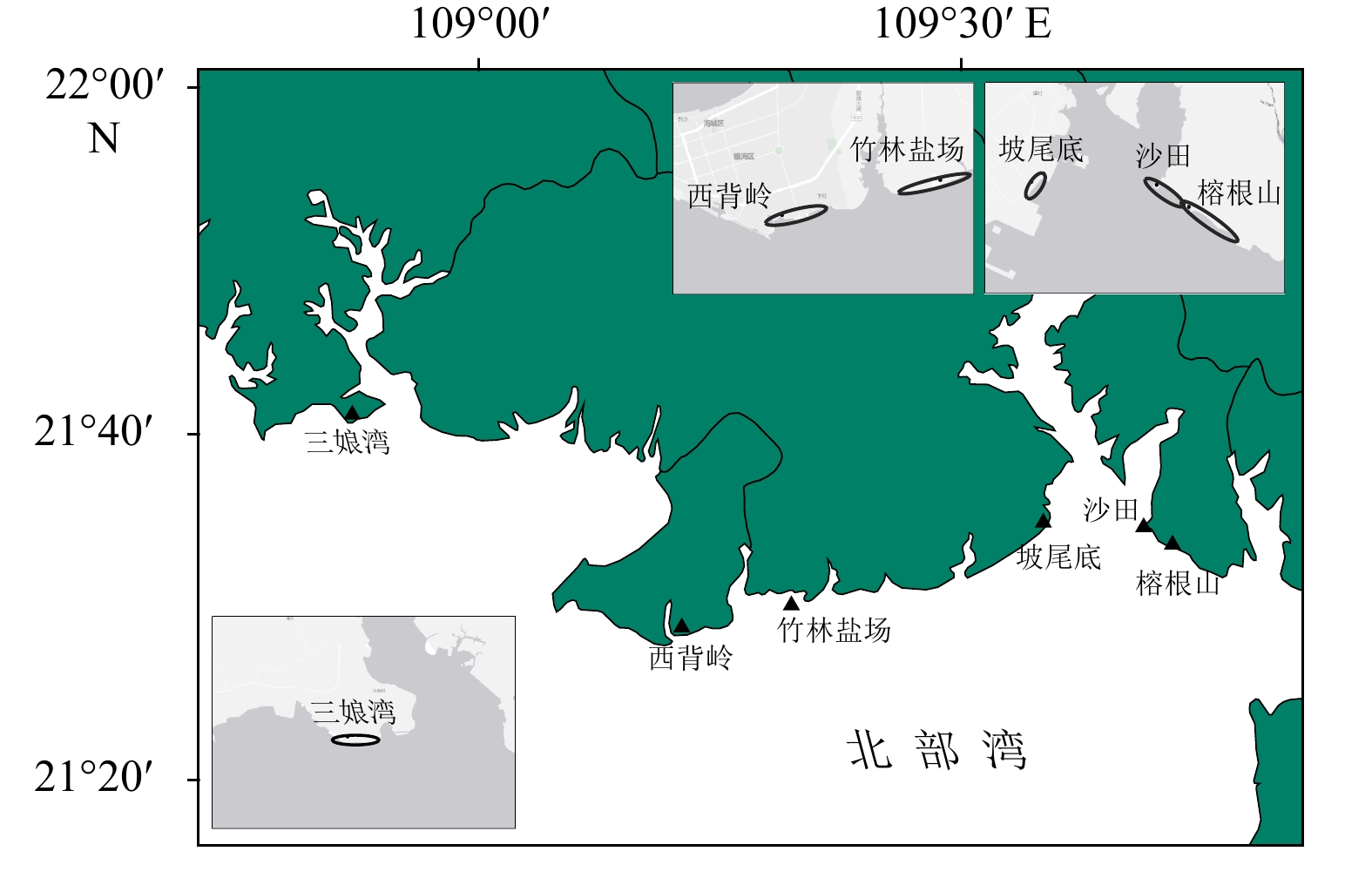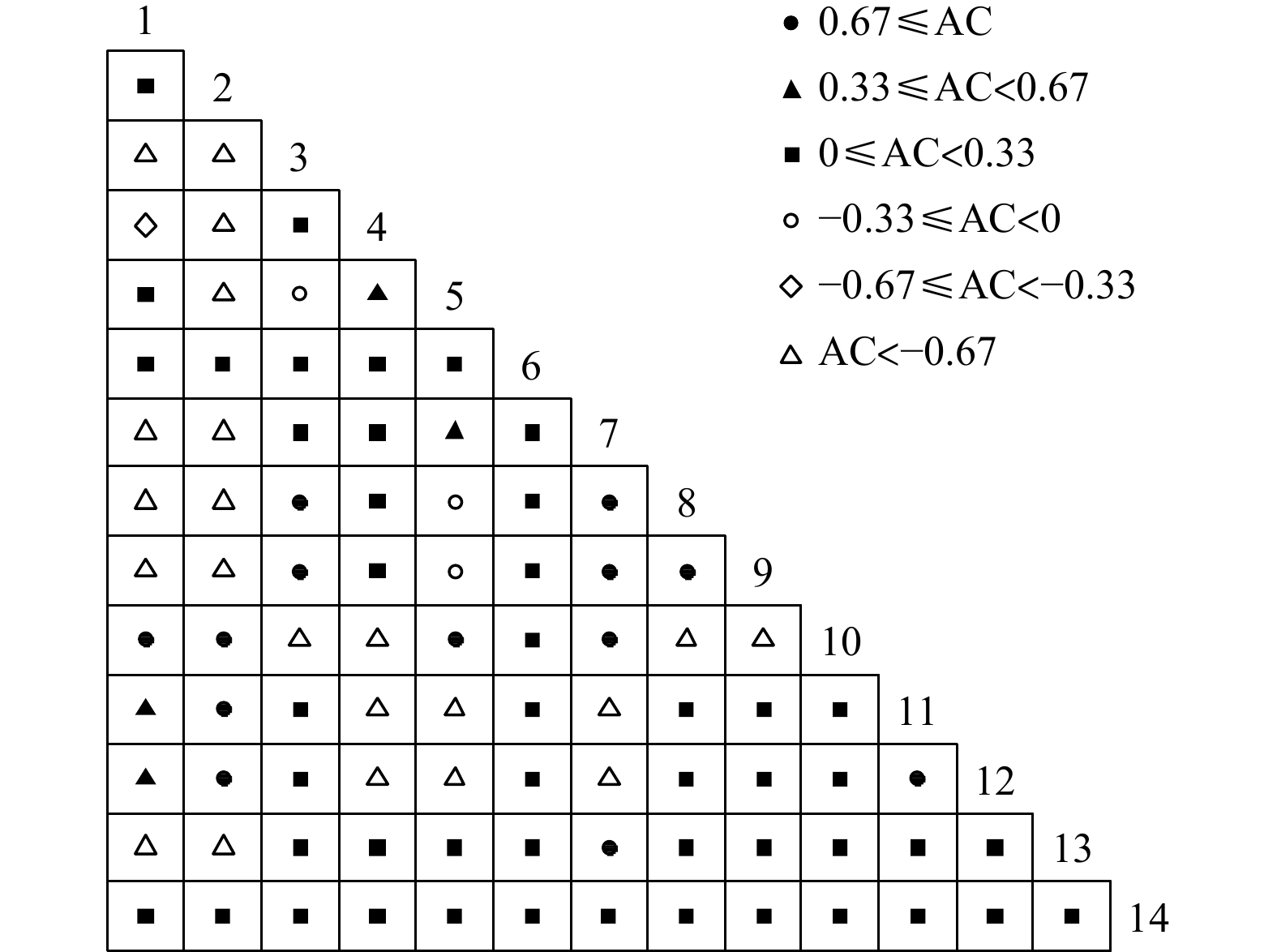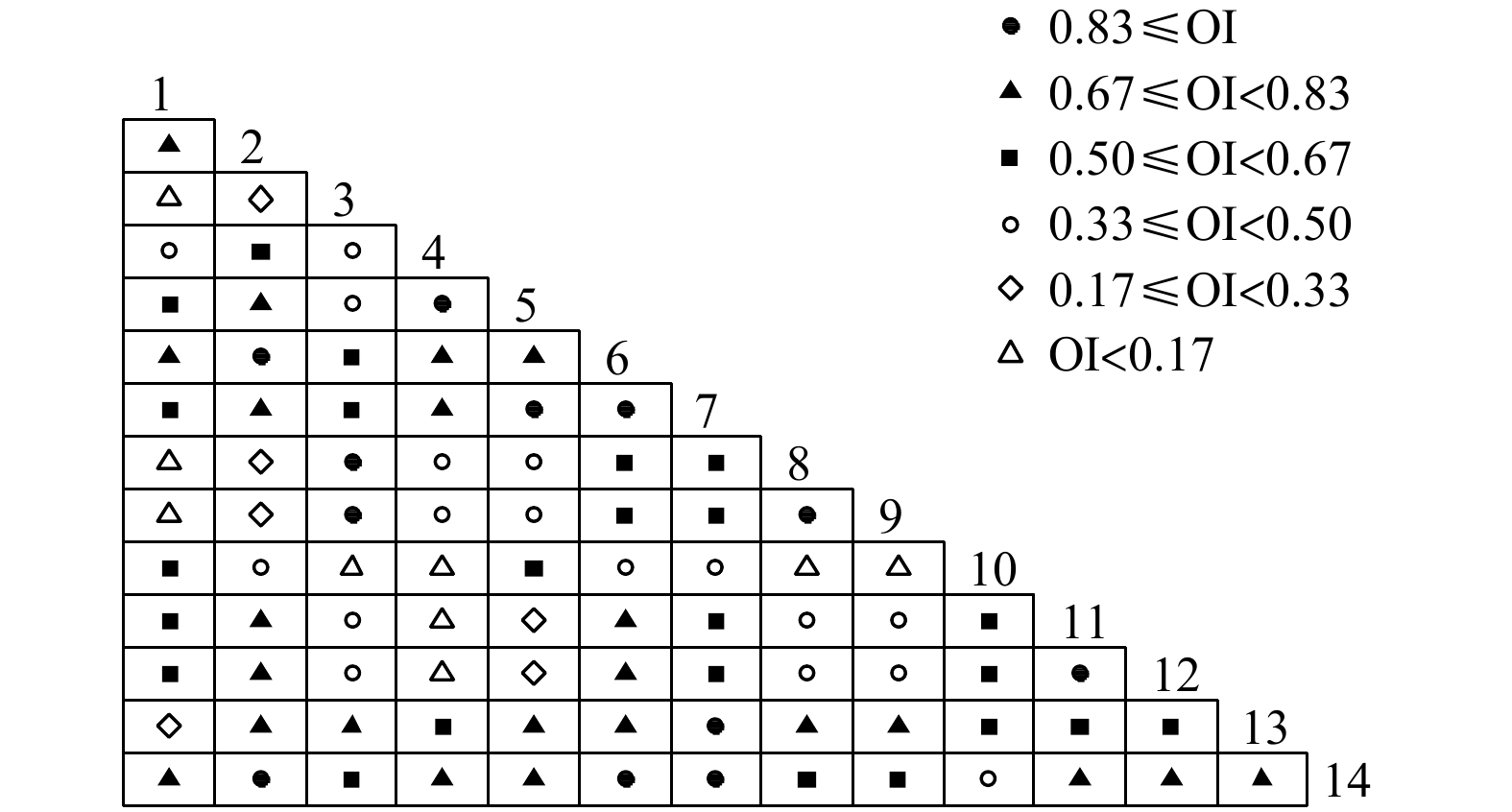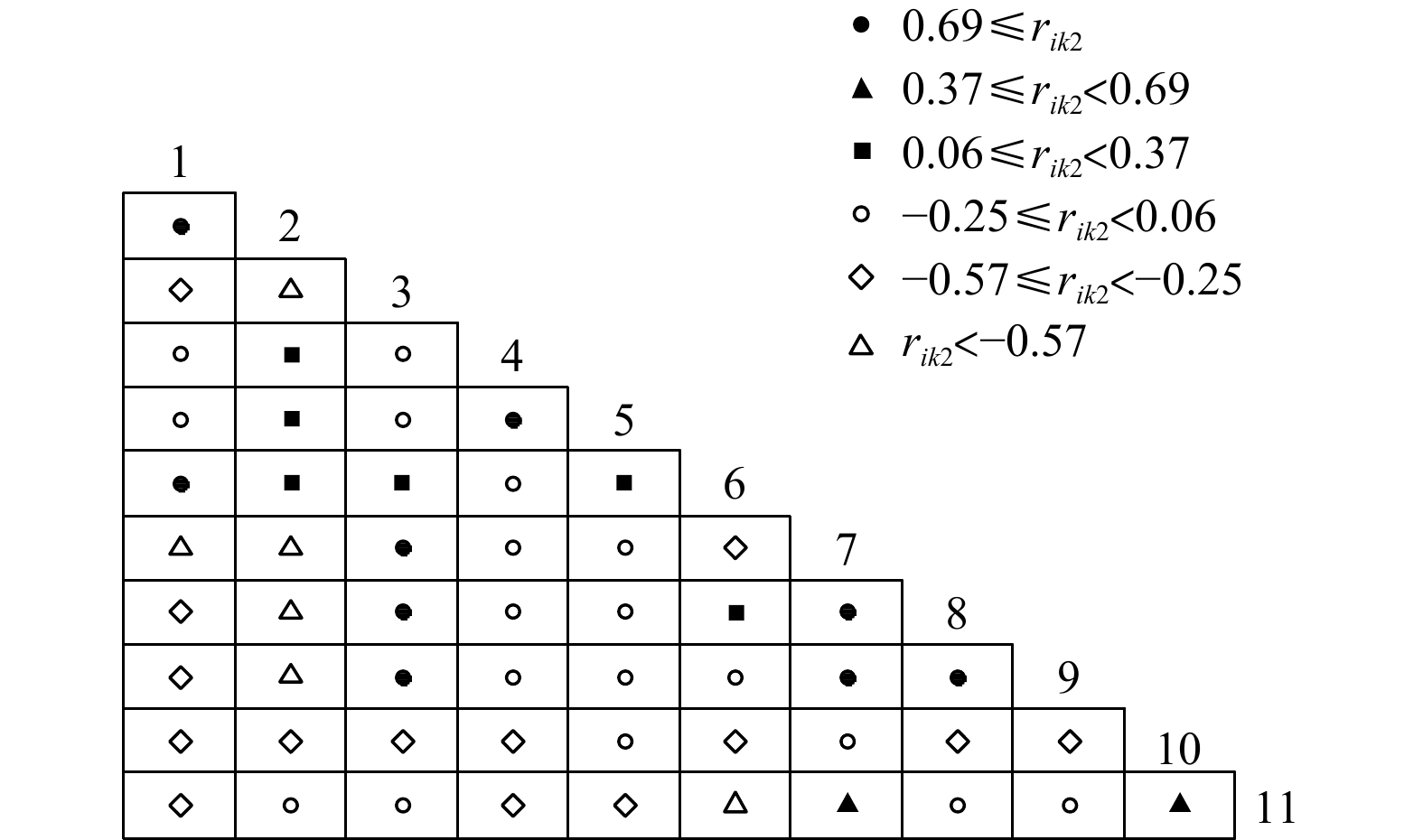Niche and interspecific association of juvenile Tachypleus tridentatus in the Beibu Gulf
-
摘要: 中华鲎(Tachypleus tridentatus)属于国家二级重点保护野生动物,近年来数量锐减已成为濒危物种。该研究基于北部湾沿岸滨海湿地中华鲎种群调查,利用中华鲎幼鲎栖息地主要大型底栖动物资源数据,采用生态位宽度和生态位重叠指数分析探讨中华鲎幼鲎对资源利用情况及其与各物种之间竞争强弱,进一步采用种间联结性探究中华鲎幼鲎与各物种竞争情况。结果表明:(1)中华鲎幼鲎在底栖群落中属于广生态位物种,其生态位宽度最大(4.252 2);(2)中华鲎幼鲎与各底栖生物均有一定程度生态位重叠,其中与短指和尚蟹(Mictyris brevidactylus)生态位重叠高达0.837 5;(3)中华鲎幼鲎与短指和尚蟹种群动态模拟结果显示,二者种群规模在西背岭和三娘湾地区呈此消彼长状态,自然补充量减少是限制种群增长的重要因素。生态位分析表明,中华鲎幼鲎可作为滨海湿地生态系统健康程度指示物种,建议以中华鲎为旗舰物种开展滨海湿地生物多样性保护和管理宣传。Abstract: Tachypleus tridentatus has been upgraded to the State Key Protection Wildlife GradeⅡ in China in 2021. The population of T. tridentatus decreased sharply in recent years. T. tridentatus has become an endangered species. Based on the investigation of coastal wetlands along the Beibu Gulf coast, the resource data of major benthic species of each habitat is added, and niche width and niche overlap index analysis are used to explore the resource utilization of juvenile T. tridentatus and inter-species competition in this study, so as to further explore the competition between juvenile T. tridentatus and various species by using interspecific connectivity. The results show that: (1) juvenile T. tridentatus belongs to a wide niche species in the benthic community, and its niche width is the largest (4.252 2); (2) the niches of juvenile T. tridentatus and various benthos are ecologically partitioned with partial overlap, among which the niche overlap with Mictyris brevidactylus is as high as 0.8375; (3) the population dynamics simulation result of juvenile T. tridentatus and Mictyris brevidactylus shows that the population size displays an opposite trend between the two species in Xibeiling area and Sanniangwan area, and the reduction of natural supplement is an important factor that limits the population growth. The research shows that the juvenile T. tridentatus can be used as the indicator species to characterize the health of coastal wetland ecosystem. It is suggested to take juvenile T. tridentatus as the flagship species to carry out biodiversity conservation, management and publicity in coastal wetland.
-
Key words:
- Tachypleus tridentatus /
- niche /
- interspecific association /
- coastal wetland /
- habitat protection
-
图 2 中华鲎幼鲎生境主要优势种种间联结系数(AC)半矩阵图
1. 中阿曼吉虫;2. 南海毛满月蛤;3. 熊本牡蛎;4. 欧努菲虫;5. 丝异须虫;6. 丽文蛤;7. 短指和尚蟹;8. 黑荞麦蛤;9. 纹藤壶;10. 小翼拟蟹守螺;11. 䗉螺;12. 突畸心蛤;13. 韦氏毛带蟹;14. 中华鲎幼鲎
Fig. 2 Semi-matrix diagram of association coefficient (AC) of dominant species in juvenile Tachypleus tridentatus nursery habitat
1. Armandia intermedia; 2. Pillucina vietnamica; 3. Crassostrea sikamea; 4. Onuphis eremita; 5. Heteromastus filiformis; 6. Meretrix lusoria; 7. Mictyris brevidactylus; 8. Xenostrobus atratus; 9. Amphibalanus amphitrite; 10. Pirenella microptera; 11. Umbonium vestiarium; 12. Cryptonema producta; 13. Dotilla wichmanni; 14. juvenile Tachypleus tridentatus
图 3 中华鲎幼鲎生境主要优势种Ochiai指数(OI)半矩阵图
1. 中阿曼吉虫;2. 南海毛满月蛤;3. 熊本牡蛎;4. 欧努菲虫;5. 丝异须虫;6. 丽文蛤;7. 短指和尚蟹;8. 黑荞麦蛤;9. 纹藤壶;10. 小翼拟蟹守螺;11. 䗉螺;12. 突畸心蛤;13. 韦氏毛带蟹;14. 中华鲎幼鲎
Fig. 3 Semi-matrix diagram of Ochiai index (OI) of dominant species in juvenile Tachypleus tridentatus nursery habitat
1. Armandia intermedia; 2. Pillucina vietnamica; 3. Crassostrea sikamea; 4. Onuphis eremita; 5. Heteromastus filiformis; 6. Meretrix lusoria; 7. Mictyris brevidactylus; 8. Xenostrobus atratus; 9. Amphibalanus amphitrite; 10. Pirenella microptera; 11. Umbonium vestiarium; 12. Cryptonema producta; 13. Dotilla wichmanni; 14. juvenile Tachypleus tridentatus
图 4 中华鲎幼鲎生境主要优势种Dice指数(DI)半矩阵图
1. 中阿曼吉虫;2. 南海毛满月蛤;3. 熊本牡蛎;4. 欧努菲虫;5. 丝异须虫;6. 丽文蛤;7. 短指和尚蟹;8. 黑荞麦蛤;9. 纹藤壶;10. 小翼拟蟹守螺;11. 䗉螺;12. 突畸心蛤;13. 韦氏毛带蟹;14. 中华鲎幼鲎
Fig. 4 Semi-matrix diagram of Dice index (DI) of dominant species in juvenile Tachypleus tridentatus nursery habitat
1. Armandia intermedia; 2. Pillucina vietnamica; 3. Crassostrea sikamea; 4. Onuphis eremita; 5. Heteromastus filiformis; 6. Meretrix lusoria; 7. Mictyris brevidactylus; 8. Xenostrobus atratus; 9. Amphibalanus amphitrite; 10. Pirenella microptera; 11. Umbonium vestiarium; 12. Cryptonema producta; 13. Dotilla wichmanni; 14. juvenile Tachypleus tridentatus
图 5 中华鲎幼鲎生境主要优势种Pearson相关系数(rik1)半矩阵图
1. 中阿曼吉虫;2. 南海毛满月蛤;3. 熊本牡蛎;4. 欧努菲虫;5. 丝异须虫;6. 丽文蛤;7. 短指和尚蟹;8. 黑荞麦蛤;9. 纹藤壶;10. 小翼拟蟹守螺;11. 中华鲎幼鲎
Fig. 5 Semi-matrix diagram of Pearson correlation coefficient (rik1) of dominant species in juvenile Tachypleus tridentatus nursery habitat
1. Armandia intermedia; 2. Pillucina vietnamica; 3. Crassostrea sikamea; 4. Onuphis eremita; 5. Heteromastus filiformis; 6. Meretrix lusoria; 7. Mictyris brevidactylus; 8. Xenostrobus atratus; 9. Amphibalanus amphitrite; 10. Pirenella microptera; 11. juvenile Tachypleus tridentatus
图 6 中华鲎幼鲎生境主要优势种Spearman秩相关系数(rik2)半矩阵图
1. 中阿曼吉虫;2. 南海毛满月蛤;3. 熊本牡蛎;4. 欧努菲虫;5. 丝异须虫;6. 丽文蛤;7. 短指和尚蟹;8. 黑荞麦蛤;9. 纹藤壶;10. 小翼拟蟹守螺;11. 中华鲎幼鲎
Fig. 6 Semi-matrix diagram of Spearman rank correlation coefficient (rik2) of dominant species in juvenile Tachypleus tridentatus nursery habitat
1. Armandia intermedia; 2. Pillucina vietnamica; 3. Crassostrea sikamea; 4. Onuphis eremita; 5. Heteromastus filiformis; 6. Meretrix lusoria; 7. Mictyris brevidactylus; 8. Xenostrobus atratus; 9. Amphibalanus amphitrite; 10. Pirenella microptera; 11. juvenile Tachypleus tridentatus
图 7 不同采样地点中华鲎幼鲎与短指和尚蟹种间关系
红色线条和蓝色曲线分别为中华鲎幼鲎与短指和尚蟹种群数量变化;a. 西背岭地区;b. 竹林盐场地区;c. 三娘湾地区
Fig. 7 Interspecific relationship between juvenile Tachypleus tridentatus and Mictyris brevidactylus in various sampling location
The red line and blue curves show the population changes of juvenile Tachypleus tridentatus and Mictyris brevidactylus, respectively; a. Xibeiling area; b. Zhulinyanchang area; c. Sanniangwan area
表 1 中华鲎幼鲎生境主要优势种生态位宽度、出现频率及优势度
Tab. 1 Niche width, occurrence frequency and dominance of dominant species in juvenile Tachypleus tridentatus nursery habitat
编号 种名 生态位宽度 出现频率 优势度 1 中阿曼吉虫 Armandia intermedia 1.022 8 0.212 1 0.068 6 2 南海毛满月蛤 Pillucina vietnamica 2.289 0 0.363 6 0.013 9 3 熊本牡蛎 Crassostrea sikamea 1.135 0 0.121 2 0.008 5 4 欧努菲虫 Onuphis eremita 2.710 8 0.333 3 0.007 8 5 丝异须虫 Heteromastus filiformis 3.252 3 0.333 3 0.005 7 6 丽文蛤 Meretrix lusoria 4.213 9 0.424 2 0.006 6 7 短指和尚蟹 Mictyris brevidactylus 3.892 6 0.333 3 0.005 8 8 黑荞麦蛤 Xenostrobus atratus 1.1509 0.100 0 0.005 0 9 纹藤壶 Amphibalanus amphitrite 2.000 0 0.121 2 0.004 0 10 小翼拟蟹守螺 Pirenella microptera 1.000 0 0.151 5 0.003 6 11 䗉螺 Umbonium vestiarium 1.684 2 0.100 0 0.000 1 12 突畸心蛤 Cryptonema producta 2.133 3 0.121 2 0.000 4 13 韦氏毛带蟹 Dotilla wichmanni 1.820 2 0.212 1 0.001 2 14 中华鲎幼鲎 juvenile Tachypleus tridentatus 4.252 2 0.084 9 0.149 5 表 2 中华鲎幼鲎生境主要优势种生态位重叠指数
Tab. 2 Niche overlap index of dominant species in juvenile Tachypleus tridentatus nursery habitat
编号 1 2 3 4 5 6 7 8 9 10 11 12 13 2 0.311 1 3 0 0.002 7 4 0.000 4 0.476 9 0.212 6 5 0.001 0 0.516 5 0.335 7 0.837 0 6 0.302 4 0.396 9 0.278 2 0.287 8 0.4755 7 0.003 6 0.131 1 0.265 6 0.315 2 0.453 8 0.715 0 8 0 0.003 0.993 0.503 9 0.954 6 >0.999 0.911 6 9 0 0.021 5 0.567 5 0.271 1 0.513 5 0.624 3 0.950 5 0.575 4 10 0.010 2 0.143 1 0 0 0.171 2 >0.999 >0.999 0 0 11 0.127 7 0.137 7 0.054 0 0.021 4 0.409 7 0.916 6 0.060 9 0.75 0.125 12 0.129 0.150 2 0.045 0 0.042 8 0.526 7 0.961 8 0.050 7 0.625 0.25 0.868 4 13 0.001 1 0.024 6 0.775 7 0.461 8 0.808 3 0.936 4 0.940 5 0.781 6 0.833 3 0.111 1 0.163 7 0.207 4 14 0.089 4 0.262 6 0.051 2 0.331 3 0.352 3 0.585 6 0.837 5 0.054 2 0.337 2 0.298 4 0.472 5 0.595 3 0.176 8 注:该表物种编号同表1。 表 3 各取样地中华鲎幼鲎与短指和尚蟹种间竞争模型参数
Tab. 3 Parameters of interspecific competition model between juvenile Tachypleus tridentatus and Mictyris brevidactylus in various sampling location
西背岭 竹林盐场 三娘湾 中华鲎幼鲎 短指和尚蟹 中华鲎幼鲎 短指和尚蟹 中华鲎幼鲎 短指和尚蟹 起始容量 19 6 23 6 34 1 固有增长率 −0.894 7 2.333 3 −0.739 1 −0.833 3 0.411 8 72 最大容量 102 38 80 17 57 72 竞争系数 0.117 4 8.520 1 0.339 8 2.942 6 0.339 8 2.942 6 -
[1] Luo Zhen, Miao Fengze, Hu Menghong, et al. Research development on horseshoe crab: a 30-year bibliometric analysis[J]. Frontiers in Marine Science, 2020, 7: 40. doi: 10.3389/fmars.2020.00041 [2] 郭清扬, 谷阳光, 鲍虞园, 等. 中华鲎的食物组成及营养位置分析[J]. 南方水产科学, 2021, 17(4): 35−40. doi: 10.12131/20200234Guo Qingyang, Gu Yangguang, Bao Yuyuan, et al. Dietary composition and trophic position of Tachypleus tridentatus[J]. South China Fisheries Science, 2021, 17(4): 35−40. doi: 10.12131/20200234 [3] Liao Yongyan, Hsieh H L, Xu Shuqing, et al. Wisdom of crowds reveals decline of Asian horseshoe crabs in Beibu Gulf, China[J]. Oryx, 2019, 53(2): 222−229. doi: 10.1017/S003060531700117X [4] Xie Xiaoyong, Wu Zhou, Wang C C, et al. Nursery habitat for Asian horseshoe crabs along the northern Beibu Gulf, China: implications for conservation management under baseline gaps[J]. Aquatic Conservation Marine and Freshwater Ecosystems, 2020, 30(2): 260−272. doi: 10.1002/aqc.3259 [5] MacArthur R. Species packing and competitive equilibrium for many species[J]. Theoretical Population Biology, 1970, 1(1): 1−11. doi: 10.1016/0040-5809(70)90039-0 [6] Li Wenjing, Zhai Dongdong, Wang Chunling, et al. Relationships among trophic niche width, morphological variation, and genetic diversity of Hemiculter leucisculus in China[J]. Frontiers in Ecology and Evolution, 2021, 9: 691218. doi: 10.3389/fevo.2021.691218 [7] 徐满厚, 刘敏, 翟大彤, 等. 植物种间联结研究内容与方法评述[J]. 生态学报, 2016, 36(24): 8224−8233.Xu Manhou, Liu Min, Zhai Datong, et al. A review of contents and methods used to analyze various aspects of plant interspecific associations[J]. Acta Ecologica Sinica, 2016, 36(24): 8224−8233. [8] 刘惠, 郭朋军, 陈洲杰, 等. 舟山近岸海域主要甲壳类的生态位及其与种间联结性[J]. 海洋学报, 2019, 41(4): 83−93.Liu Hui, Guo Pengjun, Chen Zhoujie, et al. Niche and interspecific association of main crustaceans in the nearshore waters of Zhoushan[J]. Haiyang Xuebao, 2019, 41(4): 83−93. [9] 彭彪彪, 赵峰, 王思凯, 等. 中国花鲈在长江口不同亚生境中的栖息特征[J]. 南方水产科学, 2021, 17(4): 1−8. doi: 10.12131/20210023Peng Biaobiao, Zhao Feng, Wang Sikai, et al. Habitat traits of Lateolabrax japonicus in different subhabitats of Yangtze River Estuary[J]. South China Fisheries Science, 2021, 17(4): 1−8. doi: 10.12131/20210023 [10] 邓小艳, 刘建国, 郭朋军, 等. 小洋山邻近海域主要游泳动物生态位及种间联结性[J]. 海洋学报, 2018, 40(1): 96−105.Deng Xiaoyan, Liu Jianguo, Guo Pengjun, et al. Niche and interspecific association of major nekton in Xiao Yangshan adjacent waters[J]. Haiyang Xuebao, 2018, 40(1): 96−105. [11] 潘成梅, 刘洋, 安瑞志, 等. 西藏麦地卡湿地的浮游植物——1. 优势种的时空生态位[J]. 湖泊科学, 2021, 33(6): 1805−1819. doi: 10.18307/2021.0616Pan Chengmei, Liu Yang, An Ruizhi, et al. Phytoplankton in the Mitika Wetland, Tibet, China: 1. Spatio-temporal niche of dominant species[J]. Journal of Lake Sciences, 2021, 33(6): 1805−1819. doi: 10.18307/2021.0616 [12] 翁朝红, 谢仰杰, 肖志群, 等. 福建及中国其他沿岸海域中国鲎资源分布现状调查[J]. 动物学杂志, 2012, 47(3): 40−48.Weng Zhaohong, Xie Yangjie, Xiao Zhiqun, et al. Distribution and resource of Chinese horseshoe crab (Tachypleus tridentatus) in Fujian and other coast water of China[J]. Chinese Journal of Zoology, 2012, 47(3): 40−48. [13] 朱俊华, 吴宙, 冯炳斌, 等. 全球中华鲎资源保护现状及对策建议[J]. 生物多样性, 2020, 28(5): 621−629. doi: 10.17520/biods.2019401Zhu Junhua, Wu Zhou, Feng Bingbin, et al. Global conservation of Tachypleus tridentatus: present status and recommendations[J]. Biodiversity Science, 2020, 28(5): 621−629. doi: 10.17520/biods.2019401 [14] Kwan B K Y, Un V K Y, Cheung S G, et al. Horseshoe crabs as potential sentinel species for coastal health: juvenile haemolymph quality and relationship to habitat conditions[J]. Marine and Freshwater Research, 2018, 69(6): 894−905. doi: 10.1071/MF17210 [15] 谢健. 赤皮青冈天然林优势种群间关系及生态种组划分[J]. 四川农业大学学报, 2020, 38(2): 127−134. doi: 10.16036/j.issn.1000-2650.2020.02.002Xie Jian. Interspecific relationships and ecological species division of dominant populations of natural forest in Cyclobalanopsis gilva[J]. Journal of Sichuan Agricultural University, 2020, 38(2): 127−134. doi: 10.16036/j.issn.1000-2650.2020.02.002 [16] 江焕, 张辉, 龙文兴, 等. 金钟藤入侵群落的种间联结及生态位特征[J]. 生物多样性, 2019, 27(4): 388−399. doi: 10.17520/biods.2019007Jiang Huan, Zhang Hui, Long Wenxing, et al. Interspecific associations and niche characteristics of communities invaded by Decalobanthus boisianus[J]. Biodiversity Science, 2019, 27(4): 388−399. doi: 10.17520/biods.2019007 [17] 蔡立哲, 马丽, 高阳, 等. 海洋底栖动物多样性指数污染程度评价标准的分析[J]. 厦门大学学报(自然科学版), 2002, 41(5): 641−646.Cai Lizhe, Ma Li, Gao Yang, et al. Analysis on assessing criterion for polluted situation using species diversity index of marine macrofauna[J]. Journal of Xiamen University (Natural Science), 2002, 41(5): 641−646. [18] 刘坤, 俞存根, 郑基, 等. 舟山群岛近岸海域春秋季主要鱼类功能群特征及其生态位分析[J]. 浙江大学学报(理学版), 2021, 48(5): 592−605. doi: 10.3785/j.issn.1008-9497.2021.05.011Liu Kun, Yu Cungen, Zheng Ji, et al. Analysis of functional groups characteristics and niche of major fish species in the coastal waters of Zhoushan Islands in spring and autumn[J]. Journal of Zhejiang University (Science Edition), 2021, 48(5): 592−605. doi: 10.3785/j.issn.1008-9497.2021.05.011 [19] 刘润红, 陈乐, 涂洪润, 等. 桂林岩溶石山青冈群落灌木层主要物种生态位与种间联结[J]. 生态学报, 2020, 40(6): 2057−2071.Liu Runhong, Chen Le, Tu Hongrun, et al. Niche and interspecific association of main species in shrub layer of Cyclobalanopsis glauca community in karst hills of Guilin, Southwest China[J]. Acta Ecologica Sinica, 2020, 40(6): 2057−2071. [20] Pianka E R. The structure of lizard communities[J]. Annual Review of Ecology and Systematics, 1973, 4: 53−74. doi: 10.1146/annurev.es.04.110173.000413 [21] Burger J, Tsipoura N, Niles L, et al. Heavy metals in biota in Delaware Bay, NJ: developing a food web approach to contaminants[J]. Toxics, 2019, 7(2): 34. doi: 10.3390/toxics7020034 [22] 卢占晖, 周永东, 朱文斌, 等. 浙江沿岸海域虾类优势种空间生态位分析[J]. 海洋学报, 2018, 40(2): 77−86.Lu Zhanhui, Zhou Yongdong, Zhu Wenbin, et al. Spatial niches analysis of dominant shrimp species in the coastal area of Zhejiang Province[J]. Haiyang Xuebao, 2018, 40(2): 77−86. [23] 戚诗婷, 唐以杰, 郑梓琼, 等. 广州南沙湿地大型底栖动物优势种生态位分析[J]. 湿地科学与管理, 2021, 17(3): 13−17. doi: 10.3969/j.issn.1673-3290.2021.03.03Qi Shiting, Tang Yijie, Zheng Ziqiong, et al. A niche analysis of dominant macro-benthic species in Nansha wetland in Guangzhou[J]. Wetland Science & Management, 2021, 17(3): 13−17. doi: 10.3969/j.issn.1673-3290.2021.03.03 [24] 刘贵河, 王国杰, 汪诗平, 等. 内蒙古典型草原主要草食动物食性及其营养生态位研究——以大针茅群落为例[J]. 草地学报, 2013, 21(3): 439−445.Liu Guihe, Wang Guojie, Wang Shiping, et al. Diet composition and trophic niche of main herbivores in the typical steppe of inner Mongolia[J]. Acta Agrestia Sinica, 2013, 21(3): 439−445. [25] Wathne J A, Haug T, Lydersen C. Prey preference and niche overlap of ringed seals Phoca hispida and harp seals P. Groenlandica in the Barents Sea[J]. Marine Ecology Progress Series, 2000, 194: 233−239. doi: 10.3354/meps194233 [26] 铁军, 李燕芬, 王霞, 等. 山西历山国家级自然保护区猕猴栖息地森林群落物种多样性[J]. 生态学杂志, 2015, 34(11): 3009−3015.Tie Jun, Li Yanfen, Wang Xia, et al. Species diversity of forest community in Macaca mulatta habitat in Lishan National Nature Reserve, Shanxi[J]. Chinese Journal of Ecology, 2015, 34(11): 3009−3015. [27] 刘惠, 俞存根, 郑基, 等. 杭州湾灰鳖洋海域秋季主要游泳动物生态位与种间联结[J]. 生态学报, 2019, 39(11): 3828−3836.Liu Hui, Yu Cungen, Zheng Ji, et al. Niche and interspecific association of major nekton in the Hui-bie-yang sea area of Hangzhou Bay[J]. Acta Ecologica Sinica, 2019, 39(11): 3828−3836. [28] 胡成业, 水玉跃, 田阔, 等. 浙江七星列岛海洋特别保护区主要鱼类功能群划分及生态位分析[J]. 生物多样性, 2016, 24(2): 175−184. doi: 10.17520/biods.2015225Hu Chengye, Shui Yuyue, Tian Kuo, et al. Functional group classification and niche identification of major fish species in the Qixing Islands marine reserve, Zhejiang Province[J]. Biodiversity Science, 2016, 24(2): 175−184. doi: 10.17520/biods.2015225 [29] 哀建国, 吴谷汉, 陈锦宇, 等. 石垟林场省级森林公园常绿阔叶林种群生态位特征[J]. 浙江大学学报(农业与生命科学版), 2006, 32(5): 576−584.Ai Jianguo, Wu Guhan, Chen Jinyu, et al. Niche characteristics of plant populations in evergreen broad-leaved forest in Shiyang Forestry Centre[J]. Journal of Zhejiang University (Agriculture & Life Sciences), 2006, 32(5): 576−584. [30] Cai Lizhe, Zhao Xiaoyu, Peng Wenqing, et al. Comparison of the macrozoobenthic community and sedimentary environment with and without horseshoe crab presence in the crocodile island intertidal zone, Xiamen, China[J]. Journal of Ocean University of China, 2022, 21(3): 573−582. doi: 10.1007/s11802-022-5206-9 [31] 蔡立哲, 陈昕韡, 傅素晶, 等. 厦门鳄鱼屿潮间带中国鲎的种群动态与底栖环境[J]. 湿地科学与管理, 2021, 17(1): 14−18. doi: 10.3969/j.issn.1673-3290.2021.01.03Cai Lizhe, Chen Xinwei, Fu Sujing, et al. Population dynamics and benthic environment of Tachypleus tridentatus in the intertidal zone of Eyu Islet in Xiamen[J]. Wetland Science & Management, 2021, 17(1): 14−18. doi: 10.3969/j.issn.1673-3290.2021.01.03 [32] 赵彩云, 白加德, 柳晓燕, 等. 互花米草入侵对广西北海光滩大型底栖动物群落的影响[J]. 环境科学研究, 2015, 28(3): 377−383. doi: 10.13198/j.issn.1001-6929.2015.03.07Zhao Caiyun, Bai Jiade, Liu Xiaoyan, et al. Impact of Spartina alterniflora on benthic macro-invertebrate communities in Beihai’s coastal flat, Guangxi Zhuang autonomous region[J]. Research of Environmental Sciences, 2015, 28(3): 377−383. doi: 10.13198/j.issn.1001-6929.2015.03.07 [33] Bishara A J, Hittner J B. Testing the significance of a correlation with nonnormal data: comparison of Pearson, Spearman, transformation, and resampling approaches[J]. Psychological Methods, 2012, 17(3): 399−417. doi: 10.1037/a0028087 [34] 蒋巧丽, 许永久, 郑基, 等. 浙江披山海域主要虾蟹类时空生态位及种间联结性[J]. 应用生态学报, 2021, 32(7): 2604−2614. doi: 10.13287/j.1001-9332.202107.035Jiang Qiaoli, Xu Yongjiu, Zheng Ji, et al. Niches and interspecific association of major shrimp and crab species in Pishan waters of Zhejiang Province, China[J]. Chinese Journal of Applied Ecology, 2021, 32(7): 2604−2614. doi: 10.13287/j.1001-9332.202107.035 [35] 程鹏, 周爱娜, 霍淑芳, 等. 中国鲎人工培育的幼体对不同环境适应性的研究[J]. 厦门大学学报(自然科学版), 2006(3): 404−408.Cheng Peng, Zhou Aina, Huo Shufang, et al. Study on adaptability to different environment for juvenile of horseshoe crab, Tachypleus tridentatus with artificial incubation[J]. Journal of Xiamen University (Natural Science), 2006(3): 404−408. [36] 洪水根. 中国鲎生物学研究[M]. 厦门: 厦门大学出版社, 2011.Hong Shuigen. Biology of Horseshoe Crabs, Tachypleus tridentatus[M]. Xiamen: Xiamen University Press, 2011. [37] 李琼珍, 胡梦红. 广西北海中国鲎资源现状以及保育工作进展[J]. 海洋环境科学, 2011, 30(1): 131−134. doi: 10.3969/j.issn.1007-6336.2011.01.030Li Qiongzhen, Hu Menghong. Status of Chinese horseshoe crab population and conservation advance in Beihai, Guangxi[J]. Marine Environmental Science, 2011, 30(1): 131−134. doi: 10.3969/j.issn.1007-6336.2011.01.030 [38] 李裕红, 颉晓勇, 关杰耀. 活化石中国鲎濒危现状及抢救性保护宣言[J]. 湿地科学, 2018, 16(5): 690−692. doi: 10.13248/j.cnki.wetlandsci.2018.05.017Li Yuhong, Xie Xiaoyong, Guan Jieyao. Endangered status and declaration on conservation of the “Living Fossil” Tachypleus tridentatus[J]. Wetland Science, 2018, 16(5): 690−692. doi: 10.13248/j.cnki.wetlandsci.2018.05.017 -





 下载:
下载:






